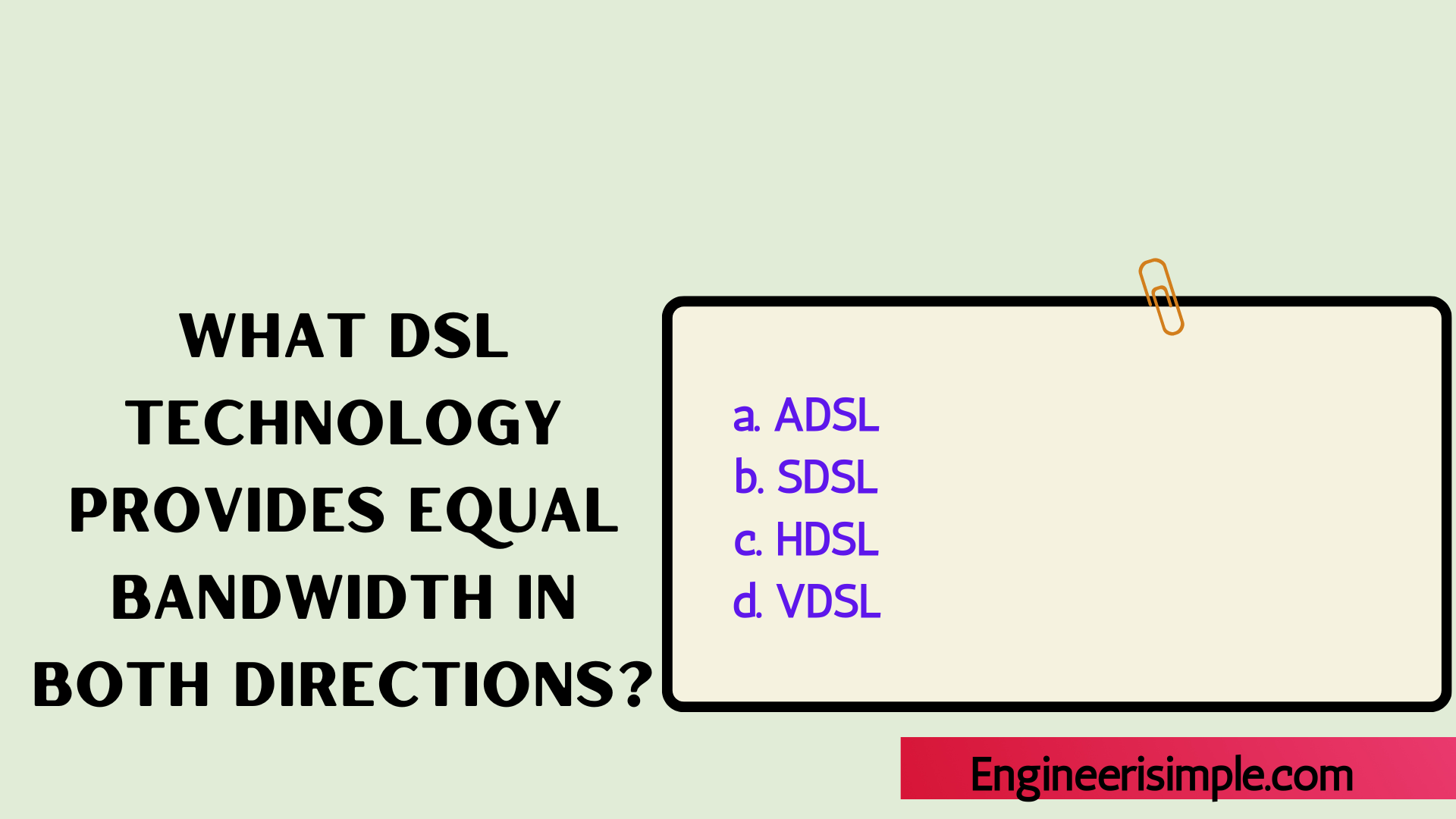What DSL Technology Provides Equal Bandwidth in both Directions?
What DSL technology provides equal bandwidth in both directions?
a. ADSL
b. SDSL
c. HDSL
d. VDSL
Answer: b. SDSL
Explanation:
SDSL (Symmetric Digital Subscriber Line) is a type of digital subscriber line (DSL) technology that provides high-speed, symmetric bandwidth on a single, dedicated telephone line. Unlike other types of DSL, SDSL sends and receives digital data at the same rate, which makes it ideal for applications that require large amounts of data to be transferred in both directions, such as video conferencing, online gaming, and VoIP (Voice over Internet Protocol) services.
SDSL Overview
SDSL is different from other forms of DSL in that it utilizes a single copper wire pair to provide the same bandwidth in both directions. This means that the same amount of data is sent and received at the same speed, providing users with an even and consistent connection. SDSL also has the advantage of being much faster than other types of DSL, with download speeds of up to 15 Mbps and upload speeds of up to 1 Mbps.
The symmetric nature of SDSL makes it particularly useful for businesses that rely on two-way communication, such as video and audio streaming services, or VoIP. Because SDSL provides the same amount of bandwidth in both directions, it is able to support multiple users simultaneously with no noticeable drop in performance. This makes it the ideal choice for businesses that need to transfer large amounts of data in both directions.
In addition to its symmetric bandwidth capabilities, SDSL also provides other benefits. It is more secure than other forms of DSL, and is less susceptible to outside interference, such as electromagnetic interference (EMI). This makes it ideal for business networks that need to keep their data secure.
Important FAQs
What is the benefit of using SDSL technology?
SDSL (Symmetric Digital Subscriber Line) technology is an internet access method that uses existing copper wires to transmit data at speeds of up to 768 Kbps.
SDSL is also known as high-speed DSL and is normally used by businesses. SDSL services are available from a variety of DSL providers and are typically more expensive than ADSL services.
SDSL services can deliver speeds ranging from 256 Kbps to 1.544 Mbps. Check out the following link to know more about SDSL technology.
What is Bandwidth?
Bandwidth is the amount of information that can be transmitted over a given amount of time. It is measured in bits per second. The larger the bandwidth, the faster the internet connection.
For example, a 256kbps connection will transmit data at 256 kilobits per second, or a 128Kbps connection at 128 kilobits per second, etc.
A cable internet connection with 30Mbps of bandwidth will transmit data 30 times faster than an Internet connection with 128Kbps bandwidth.
What is DSL Technology?
DSL Technology delivers digital data over telephone lines, just like regular phone service. However, DSL has faster Internet speed than dial-up Internet access. DSL works by taking advantage of existing phone wires to carry digital data.
DSL works through a process called _ modulation _ which changes digital information into a type of analog signal. The analog signal is then brought over a phone line to the user.
Once the signal reaches the user, it is converted back into a digital signal and the user's computer reads it and turns it back into information.
How DSL Technology Works?
DSL technology uses telephone wires for connectivity between the customers and the Internet Service Provider (ISP). The DSL modem provided by the ISP converts the data from the Internet protocol to the local area network (LAN) and vice versa.
DSL connections are available through a number of channels – Integrated Services Digital Network (ISDN), basic rate interface (BRI), and primary rate interface (PRI). ISDN, also known as single channel per carrier (SCPC), is limited to one 64 Kbps channel.
The BRI is a channelized connection, which provides 23 B channels of 64 Kbps each, and a D channel of 64 Kbps. The PRI, or the primary rate interface, is a channelized connection that provides 24 channels of 64 Kbps each.
Final Words
SDSL is an ideal choice for businesses that need fast, symmetric bandwidth and reliable connections. With its symmetric capabilities, SDSL ensures that users receive an equal amount of bandwidth in both directions, allowing them to take advantage of a variety of applications without having to worry about connection speed.




.png)

